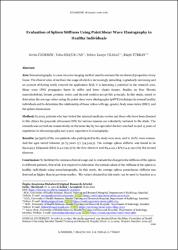| dc.contributor.author | Özdemir, Sevim | |
| dc.contributor.author | Selçuk Can, Tuba | |
| dc.contributor.author | Yılmaz, Behice Kaniye | |
| dc.contributor.author | Türkay, Rüştü | |
| dc.date.accessioned | 2023-09-05T11:46:29Z | |
| dc.date.available | 2023-09-05T11:46:29Z | |
| dc.date.issued | 2022 | en_US |
| dc.identifier.issn | 2536-4499 | |
| dc.identifier.issn | 2602-2605 | |
| dc.identifier.uri | https://hdl.handle.net/11363/5426 | |
| dc.description.abstract | Aim: Sonoelastography is a non-invasive imaging method used to evaluate the mechanical properties of any
tissue. The clinical value of method, the usage of which is increasingly prevailing, is gradually increasing and
on account of having newly entered the application field, it is becoming a potential in the research area.
Shear wave (SW) propagates faster in stiffer and lower elastic tissues. Studies on liver fibrosis
musculoskeletal, breast, prostate, testis, and thyroid nodules accept this principle. In this study, aimed to
determine the average values using the point shear wave elastography (pSWE) technique in normal healthy
individuals and to determine the relationship of these values with age, gender, body mass index (BMI), and
the spleen dimensions.
Method: In 2019, patients who had visited the internal medicine service and those who have been directed
to this clinics for grayscale ultrasound (US) for various reasons are voluntarily included in the study. The
research was carried out consecutively on the same day by two specialist doctors who had 10 and 15 years of
experience in ultrasonography and 3-year experience in elastography.
Results: 39 (39%) of the 100 patients who participated in the study were men, and 61 (61%) were women.
And the ages varied between 32-75 years (y) (54,5±9,5). The average spleen stiffness was found to be
89,2±43,3 kilopascal (kPa) (14,2-152,3) by the first observer and 89,4±41,1 kPa (14,4-151,1) by the second
observer.
Conclusion: To facilitate the common clinical usage and to evaluate the change in the stiffness of the spleen
in different patients, first of all, it is required to determine the normal values of the stiffness of the spleen in
healthy individuals using sonoelastography. In this study, the average spleen parenchyma stiffness was
detected as higher than in previous studies. The values obtained in this study can be used to function as a comparison to determine the spleen stiffness. They can be used as referential to examine the different spleen
pathologies in the clinical environments that use Esaote myLab device and pSWE method. | en_US |
| dc.description.abstract | Amaç: Sonoelastografi, dokunun mekanik özelliklerini değerlendirmede kullanılan noninvaziv bir
görüntüleme yöntemidir. Kullanımı giderek yaygınlaşan bu yöntemin klinik değeri giderek artmakta olup
bazı cihazların uygulama alanına yeni girmiş olması nedeniyle araştırma alanında potansiyel
oluşturmaktadır. Daha sert ve elastisitesi daha düşük dokularda kayma dalgası daha hızlı yayılmaktadır.
Karaciğer fibrozu, kas-iskelet sistemi, meme, prostat, testis ve tiroid nodülleri üzerine yapılan çalışmalar bu
prensibi kabul etmektedir. Bu çalışmada normal sağlıklı bireylerde dalak sertliğini pSWE tekniği
kullanılarak kantitatif olarak değerlendirerek ortalama değerleri saptamayı ve bu değerlerin yaş, cinsiyet,
vücut kitle indeksi ve dalak boyutları ile ilişkisini saptamayı amaçlanmıştır.
Yöntem: 2019 yılında Dahiliye kliniğine başvuran, farklı nedenlerle rutin gri skala US için Radyoloji
kliniğine yönlendirilen hastalardan gönüllü olan bireyler çalışmaya dahil edilmiştir. Araştırma, US alanında
10 ve 15 yıllık, elastografi alanında ise 3 yıllık deneyime sahip iki uzman doktor tarafından aynı gün içinde
ardışık olarak gerçekleştirilmiştir.
Bulgular: Çalışmaya dahil 100 hastanın 39’u (39%) erkek, 61’i (61%) kadın olup yaşları 32-75 (54,5±9,5)
arasında değişmekte idi. Ortalama dalak sertliğini birinci araştırmacı 89,2±43,3 kPa (14,2-152,3), ikinci
araştırmacı 89,4±41,1 kPa (14,4-151,1) olarak saptamıştır.
Sonuç: Yaygın klinik kullanımını kolaylaştırmak için ve farklı hastalıklarda dalak sertliği değişikliklerinin
değerlendirilebilmesi için öncelikle sağlıklı bireylerde sonoelastografi ile dalak sertliğinin normal
değerlerinin belirlenmesi gerekmektedir. Bu çalışmada sağlıklı bireylerde ortalama dalak parankim sertliği
diğer çalışmalara göre yüksek olarak tespit edilmiştir. Bu çalışmada elde ettiğimiz değerlerin Esaote myLab9
cihazı ve pSWE yöntemi kullanan klinik ortamlarda dalak sertliğini belirlemek için bir karşılaştırma işlevi
görebileceğine, farklı dalak patolojilerinin incelenmesinde referans değerler olarak kullanılabileceğini
düşünülmektedir. | en_US |
| dc.language.iso | eng | en_US |
| dc.publisher | İstanbul Gelişim Üniversitesi Yayınları / Istanbul Gelisim University Press | en_US |
| dc.relation.isversionof | https://doi.org/10.38079/igusabder.1033907 | en_US |
| dc.rights | info:eu-repo/semantics/openAccess | en_US |
| dc.rights | Attribution-NonCommercial-NoDerivs 3.0 United States | * |
| dc.rights.uri | http://creativecommons.org/licenses/by-nc-nd/3.0/us/ | * |
| dc.subject | Spleen | en_US |
| dc.subject | stiffness | en_US |
| dc.subject | point shear wave elastography | en_US |
| dc.subject | Dalak | en_US |
| dc.subject | sertlik | en_US |
| dc.subject | nokta kayma dalgası elastografi | en_US |
| dc.title | Evaluation of Spleen Stiffness Using Point Shear Wave Elastography in Healthy Individuals | en_US |
| dc.title.alternative | Sağlıklı Bireylerde Dalak Sertliğinin Point Shear Wave Elastografi ile Değerlendirilmesi | en_US |
| dc.type | article | en_US |
| dc.relation.ispartof | İstanbul Gelişim Üniversitesi Sağlık Bilimleri Dergisi | en_US |
| dc.department | İstanbul Gelişim Üniversitesi | en_US |
| dc.authorid | https://orcid.org/0000-0003-4270-6370 | en_US |
| dc.authorid | https://orcid.org/0000-0002-2388-1715 | en_US |
| dc.authorid | https://orcid.org/0000-0001-6842-3323 | en_US |
| dc.authorid | https://orcid.org/0000-0002-7837-9861 | en_US |
| dc.identifier.issue | 18 | en_US |
| dc.identifier.startpage | 1006 | en_US |
| dc.identifier.endpage | 1018 | en_US |
| dc.relation.publicationcategory | Makale - Ulusal Hakemli Dergi - Başka Kurum Yazarı | en_US |



















